Looking back 20 years on thoughts about the Independent Living movement.
Editor’s Note: This is an unpublished and unfinished article from twenty years ago. Tim Wheat had just completed a cross-country bicycle trip visiting Centers for Independent Living and disability rights demonstrations. Tim Wheat has highlighted his current thinking in italics while the original text is not italicized.
September 23, 2002
September 23, 2022
By Tim Wheat
Twenty years ago I believe I had a lot to say about the direction of Independent Living, but I never finished or explained what I had found on my cross-country visit to other Centers for Independent Living. I re-examine some of my thoughts in the paragraphs below.
The Independent Living (IL) movement does not lack direction because it has been unsuccessful, on the contrary, the IL movement seems to make good sense in a wide variety of disability related areas. It is because of this wide-spread appeal of IL rhetoric that the “direction” of the movement is hard to gauge.
PHOTO: Tom Kirby at the Roswell Center for Independent Living in New Mexico. One of the Centers I visited on my six month bicycle adventure across the country.
Twenty years ago, I visited several Centers for Independent Living on a special assignment from MCIL’s Executive Director Deborah Cunningham. What I was attempting to point out in this opening paragraph was that I was able to see the Independent Living movement reflected in all parts of the disability community, and not unique to CILs.
Social workers spoke of client choice, person centered planning and independent living. Apartments, especially for older Americans, were adopting the moniker: Independent Living. Larger, older and better funded agencies switched from “case managers,” who may be involved in every aspect of a “case,” to only being the gatekeeper for a particular funding stream or program.
Twenty years ago I thought I was viewing the great success of the IL movement, but now, twenty years later and more than forty years since the beginning of federally funded CILs, I do not see the same success. In 2002 I saw Centers that were diligently working to include people with disabilities in a variety of ways, but what they did not do was to make themselves the center of Independent Living and faithfully promote and defend the Independent Living movement.
The historical components of the IL Center have become unnecessary because of the ADA and a change in social attitudes. Many CILs talk about the “four core services,” yet these services no longer are effective at meeting the needs of people with disabilities attempting to live independently. Please examine these core services when Title VII was written as compared to today.
Twenty years ago there were four core services: Information and referral, Independent Living skills training, peer counseling and advocacy. Now CILs have a fifth core service that can be described as transition. Transition from a nursing home or institution into the community and transition from school-age youth to an independent adulthood.
If you are not familiar with Independent Living, the idea of core services sounds pretty basic. The movement was progressive at the time and was similar to the Vocational Rehabilitation system that had developed. “Cases” moved, progressed and were tracked in a system that was centered on a file and a counselor, case worker or social worker.
The federal regulations that make up CILs and the reporting were before the 1990 Americans with Disabilities Act and lacked a lot of clarity. The “services” that IL Centers offer are broadly defined. There are a list of 17 services and yet the four core services are not the backbone of that list.
One problem with the long list is that it is never clear what a CILs is to do. Everything will fit under advocacy. I cannot see how each thing that we do is either systems advocacy, self advocacy or individual advocacy. The CIL working with people with disabilities to improve the system, build on disability rights and promote community inclusion all are system advocacy. Teaching an individual with a disability to navigate barriers because of their disability is self-advocacy and advocating for someone with a disability issue is individual advocacy. I believe CILs could do their work with advocacy as the only service category.
Teaching someone to ride the bus can be IL Skills Training, while providing transportation can be a service that directly interferes with a person’s independence. If someone learns to depend on the CIL for transportation, they are less independent. I believe Centers for Independent Living were originally designed to advocate and help sustain reliable accessible transportation for people with disabilities.
Many CILs got funding to provide transportation and the IL focus of the Centers changed to providers who talked about inclusion, yet profited from a segregated system.
Thirty-two years ago when the ADA was signed, public transportation was to become accessible and include people with disabilities. Paratransit systems were to provide transportation for people with disabilities who could not access the main-line public transportation system because of their disability.
The concept was that as fixed-route public transportation became accessible, paratransit would become unnecessary or less necessary. Now in 2022, paratransit in Memphis is as large as it was in 2002. MCIL has not only experienced push-back from local people with disabilities who do not wish to have an integrated public transit system, but we have dual advocacy of supporting accessibility of the fixed-route, while we promote the use of the segregated paratransit system.
PHOTO: Crossing the Continental Divide on my way to visit two CILs in Utah and the ADAPT National Meeting in Salt Lake City. Notice the ADAPT t-shirt hand painted by Sher Stewart.



No comments:
Post a Comment